
Für eine deutsche Übersetzung dieser Seite einfach die Brandenburger Flagge anklicken
 |
Click the Brandenburg Flag for a German translation Für eine deutsche Übersetzung dieser Seite einfach die Brandenburger Flagge anklicken |


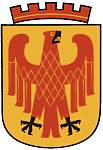 |
Home Towns - Potsdam, GermanyThe Old Market SquareOld Town Hall & Knobelsdorff House |
 |


 |
This site is part of our Old Market Square page, which is part of our Potsdam, Germany site. Click left the left turn sign to return to the Old Market Square site or the u-turn sign to get back to our Potsdam Start Site. |

|


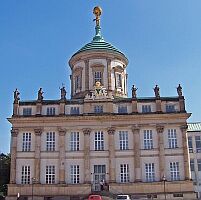 |
 |
 |
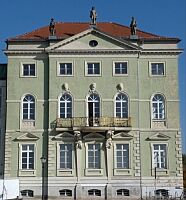
|

| In the 1730s a number of houses were built at the east side of the Old Market Square, but they didn't last for very long. When King Frederick the Great ordered a total reconstruction of the Square, the inhabitants had to leave and all houses at the east side - with the exception of Bakery Windelband – were demolished and new buildings were designed in their place. |

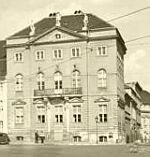 Knobelsdorff House in 1928 |
Knobelsdorff House
In 1750, architect
von Knobelsdorff
built a baroque house at the right side of the square's east front. The renowned architect never
lived in the house, but until this day, it bears his name.
|

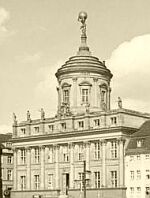 Old Town Hall in 1928... ...and in 1945 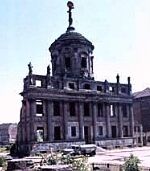
|
Old Town Hall
For almost 500 years, this place has been the home of Potsdam's city administration. The first town hall was built
here in 1524, but it was completely destroyed only twelve years later in the town's worst fire on June 24, 1536. A
second town hall was built soon after. This second building was in use until 1722, when the growing town demanded a
larger, more representative building. This third town hall, a frame house with a wooden steeple was used for thirty
years, but soon, is was too small too.
|

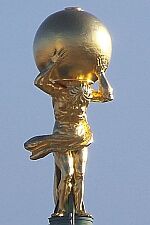
|
Atlas
 Here, the architects confused Roman history with the 1,000 years older Greek Mythology and made Greeks Titan Atlas one of the central features of the square. The original statue was made of gold-plated lead but turned out to be too heavy and fell down after only two years. Since 1877, the statue consists of gold-plated copper. Being a true Titan, Atlas survived everything the last 250 years threw at him – from hail storms to carpet bombing – and is now one of Potsdam's most recognizable landmarks.  Potsdam's citizen didn't care much about Greek or Roman mythology and, somewhat disrespectfully, called the statue "The Doll." Consequently, the jail under Atlas' roof was called "The Doll-House." |
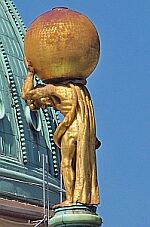
|

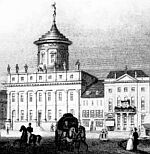 Windelband House in 1835, sandwiched between Town Hall and Knobelsdorff House |
Bakery Windelband
 The Windelband house was built in 1735 and was supposed to be demolished together with the other houses at the east front to make room for a larger town hall building. But the owner, baker Windelband successfully intervened and was allowed to keep his house - it just got a new baroque forefront.  Unfortunately, what could have been the oldest building in town was demolished in the beginning of the 20th century and replaced with a functional building, connecting the other two houses. That building was destroyed in World War II and later replaced with a modern one. |
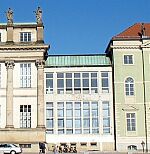 Post-war replacement of the Windelband House
Post-war replacement of the Windelband House
|


Palais Barberini
 For completeness sake, here is the building that once covered the south front of the square. Palais Barberini was built in 1771 by architect Carl Phillip Christian von Gontard. The pictures to the right show front and back in 1940, when the Palais hosted the city administration, a library, a museum and a hostel. It was destroyed in 1945 and later completely demolished. It will be rebuilt together with the City Palace by 2012. |
 |
 |

|
Click the left turn sign to return to the Old Market Square site or make your pick form the menu below. |
 |
 Back to Potsdam Page |
 Back to Home Towns |
 Back to Germany Page |
 Back to English Main Page |
 Back to Start Page |